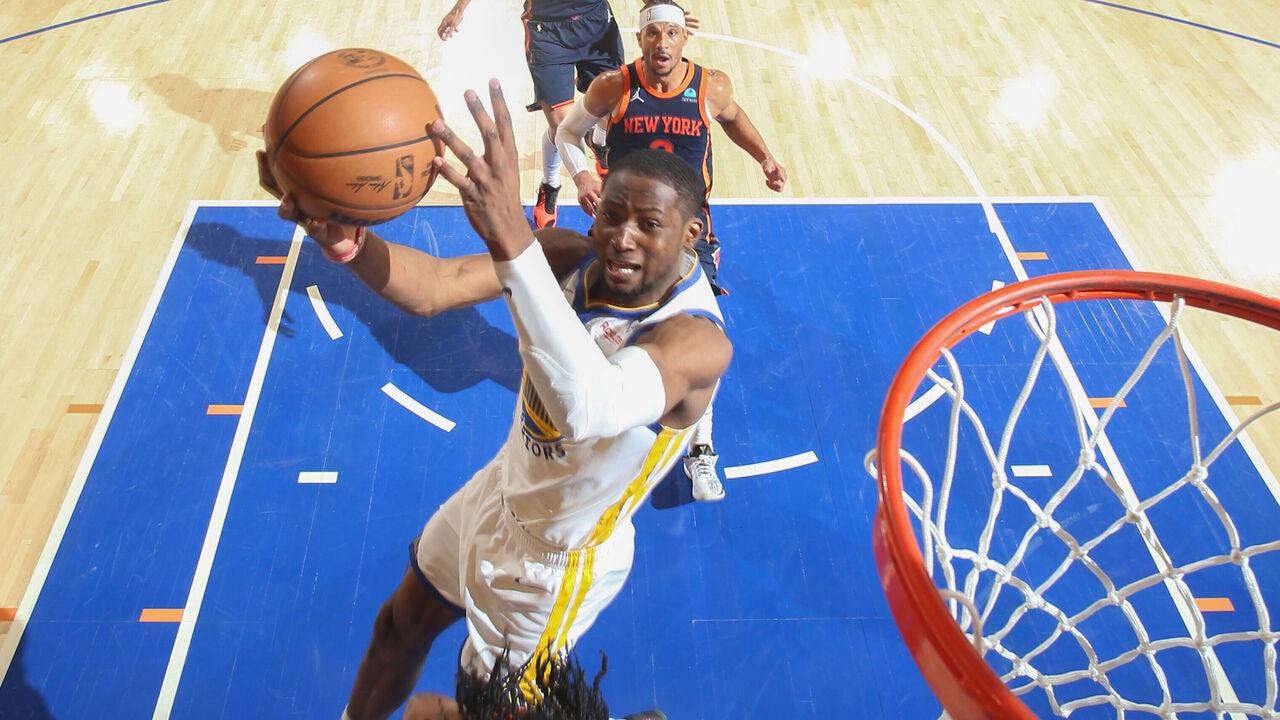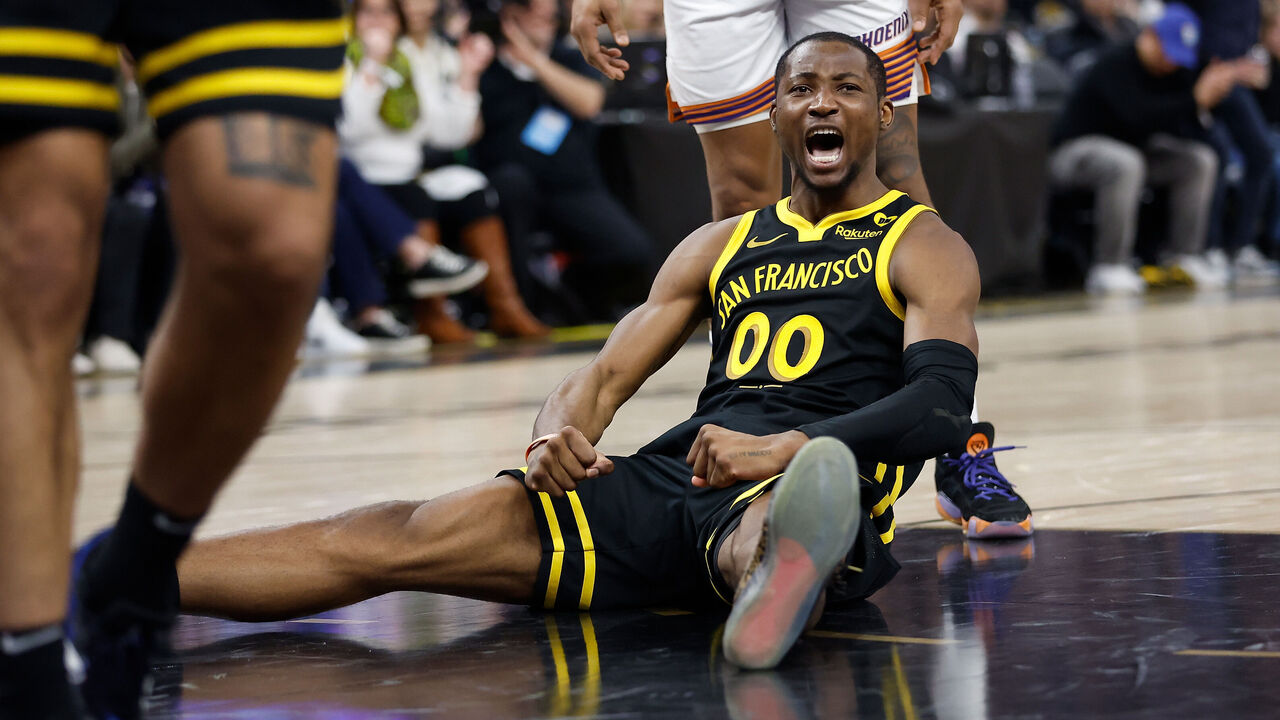A Jonathan Kuminga star turn might reverse the Warriors' decline
With the 2024-25 campaign approaching, we're diving deep into some of the players we're most interested in watching. Next up: an emerging young forward whose continued development could slow the decay of a crumbling dynasty.
Previous entries: Damian Lillard, Darius Garland, Christian Braun, Jalen Green, Devin Vassell, Memphis Grizzlies
When the infamous "Two Timelines" concept came into focus in Golden State a few years back, the organization probably had something akin to this past offseason in mind when considering how and when a natural transition would commence.
After 13 years, the Warriors bid farewell to Klay Thompson, finally accepting a significant change to their aging dynastic core. Stephen Curry and Draymond Green are still here and still mostly excellent at the things they've always excelled at. But they're 36 and 34, respectively, and no longer the world-destroyers they once were at either end of the floor. To bridge eras of contention, now would be the time for the team's youth brigade to bring that old Ninja Turtles/Master Splinter meme to life.
Instead, the chasm between Curry and the rest of the roster looks as large as ever, and the Warriors appear much more likely to spend his twilight years clawing for play-in berths than competing for championships. Heck, they got 75 games from Curry last season and didn't even make the playoffs proper. The planned bridge to the future is nowhere close to complete, and a lot of the materials the team initially intended to use have since been cast aside. (Which is to say, the James Wiseman gambit flopped spectacularly and the Jordan Poole experience took a depressing turn.)
Representing the most important remaining plank, the one that will likely determine whether this Golden State Bridge has any structural integrity, is Jonathan Kuminga. The hyper-athletic forward is fresh off a breakout campaign and is still a few weeks shy of his 22nd birthday. With Thompson gone, Green slipping, Andrew Wiggins seemingly falling off a cliff prematurely, and no other youngster ready to ascend to fill the void (save maybe sophomore Brandin Podziemski), the question of whether internal development can buoy the tail end of the Curry era largely hinges on Kuminga.
The good news is, three years into his career, he's already a strong complementary player. He's a bulldozer who pressures the rim in a way nobody else on the Warriors can even come close to. He's a beast in transition, and in the half court he's gotten savvy at playing off of Curry's gravity and Green's passing - ducking in, cutting, and flashing into open space for quick dump-offs. He shot 74% at the rim last season, an 88th-percentile mark among his forward cohort, per Cleaning the Glass. And while he's still a fairly dependent scorer, it's notable that nearly 40% of his 2-point makes were unassisted.

Kuminga hasn't yet developed the playmaking feel to fully mesh with Steve Kerr's motion-based, read-and-react offense, but the level of force he plays with gives the Warriors a different dimension. They need that dimension now more than ever, given that the beating heart (Curry) and brain (Green) of Kerr's revolutionary system are in states of gentle decline.
Something that became abundantly clear last season is that Kuminga has to play the four. Once the Warriors acknowledged as much and gave up on the idea of playing lineups with him, Green, and a traditional center on the floor, Kuminga's production and the team's performance improved significantly. In 665 minutes with Kuminga and Green on the floor without another big man, Golden State outscored opponents by 11.9 points per 100 possessions, according to PBP Stats.
When opposing defenses cross-matched their centers onto Kuminga and put their fours on Green (the better to switch Curry-Green pick-and-rolls), it activated Kuminga as a ball-screener and roll man. He improved his timing on the roll, got better at disguising and flipping his screen angles, and got more reps screening for Curry as the season went along. He's such a powerful finisher that any low man who isn't a true big has almost no chance of deterring him once he gets behind the screen defender. The Warriors also ran the odd inverted action with those two, whereby Curry would leverage a top lock to essentially screen two guys at once and Kuminga would burst downhill and be on top of the rim before the defense could blink.
When he got smalls on switches, he could take them into the post and either mash them in single coverage or draw double-teams that he got increasingly comfortable passing out of, occasionally even slinging skip passes to the corner when the doubles came from the weak side. It all translated to eye-catching production: 21.9 points per 36 minutes on 60% true shooting.
So, that's all very encouraging. But given their dearth of top-end talent outside of Curry, the Warriors in their present construction won't get very far unless Kuminga takes another sizeable leap forward. They're banking on him growing into a star and soon. That would mean expanding his shooting, ball-handling, playmaking, and defensive capabilities. This season should tell us a lot about how realistic that is.
Kuminga actually shot threes at a pretty respectable clip the last two seasons - hitting 34% overall and 41% from the corners - but the volume was very low and defenses still don't respect him on the perimeter, especially not above the break. His forays into self-creation were still adventurous in the wrong kind of way, especially when he was defended by like-sized players. Even with his aforementioned growth as a passer, his vision remained limited, his reads stilted. He has nearly as many turnovers as assists for his career. Simply improving as a short-roll playmaker would be a great place to start.

Then there's his defense, which has been a real mixed bag. He's solid on the ball, where he can put his strength, length, and short-area agility to good use. But as a team defender, he's still prone to late rotations and blowing help-the-helper assignments. He's also a pretty lousy rebounder for someone with his size and athleticism. And those issues raise concerns when he's going to primarily be playing beside Green in small-ball lineups that are light on primary rim protection.
The Warriors tumbled from second in defensive efficiency during their championship season in 2021-22 to 14th the following season and 15th last year. Their offseason moves seemed geared toward reclaiming that lost defensive identity, subtracting Thompson and adding long-armed stoppers in De'Anthony Melton and Kyle Anderson. Kuminga should be part of that reclamation, given his physical gifts. It's time for him to actualize his potential at that end of the floor.
The Warriors no longer seem particularly invested in the "Two Timelines" project - they were clearly prepared to trade a chunk of future capital for 34-year-old Paul George this offseason - but they're still invested in Kuminga. (Reports indicated that they balked at including him in trade offers for Lauri Markkanen.) We'll find out pretty soon how far they're willing to push that investment. He's eligible to sign an extension right now or can become a restricted free agent next summer.
Kuminga isn't the only hope for upward mobility in Golden State: Podziemski, Moses Moody, and Trayce Jackson-Davis are all varying degrees of promising, Wiggins might have a bounce back in him, and the front office could still find an opportunity to make a needle-moving trade. But for now, Kuminga feels like the team's best hope, and considering what his development could mean for the twilight years of one of this generation's defining players, he's one of the most interesting figures of the 2024-25 campaign.
Joe Wolfond covers the NBA for theScore